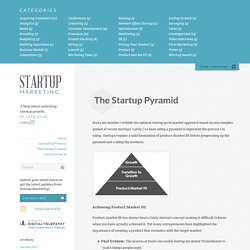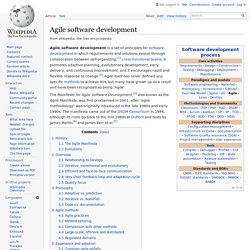

The Startup Pyramid. Every six months I rethink the optimal startup go to market approach based on new insights gained at recent startups.

Lately I’ve been using a pyramid to represent the process I’m using. Startups require a solid foundation of product/market fit before progressing up the pyramid and scaling the business. Achieving Product/Market Fit Product/market fit has always been a fairly abstract concept making it difficult to know when you have actually achieved it. 3 Rules to Actionable Metrics. 334 Flares544535100100--×334 Flares x Access to videos, talks, and worksheetsInvitation to private Google Plus CommunityJoin in on live Q&A webinars and fireside chats.

Eric Ries Lean Startup Schematic View Of Agile Development And Customer Development. Agile software development. Agile software development is a set of principles for software development in which requirements and solutions evolve through collaboration between self-organizing,[1] cross-functional teams.

It promotes adaptive planning, evolutionary development, early delivery, and continuous improvement, and it encourages rapid and flexible response to change.[2] Agile itself has never defined any specific methods to achieve this, but many have grown up as a result and have been recognized as being 'Agile'. The Manifesto for Agile Software Development,[3] also known as the Agile Manifesto, was first proclaimed in 2001, after "agile methodology" was originally introduced in the late 1980s and early 1990s. The manifesto came out of the DSDM Consortium in 1994, although its roots go back to the mid 1980s at DuPont and texts by James Martin[4] and James Kerr et al.[5] History[edit] Incremental software development methods trace back to 1957.[6] In 1974, E.